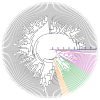A Model for Selecting Kiwifruit (Actinidia eriantha) Germplasm Resources with Excellent Fruit Quality
- PMID: 39766957
- PMCID: PMC11727286
- DOI: 10.3390/foods13244014
A Model for Selecting Kiwifruit (Actinidia eriantha) Germplasm Resources with Excellent Fruit Quality
Abstract
The evaluation of quality traits is an important procedure for kiwifruit breeding and comprehensive utilization. The present study aimed to establish a comprehensive system to assess Actinidia eriantha germplasms by analyzing 22 quality traits on kiwifruit samples collected from a wild population of 236 plants grown in the Jiangxi Province, China. Variability, correlation, principal components, and cluster analyses were carried out using the data collected from fruit quality evaluations. The coefficients of variation (CV) of fruit quality traits ranged from 11.66 to 66.16% (average coefficient = 35.09%), indicating a high level of variation among the 236 plants. In addition, different degrees of correlations were found between the traits, with similar traits demonstrating strong correlations. Principal component analysis (PCA) generated eight comprehensive and independent principal components, accounting for 77.93% of the original fruit quality information. Furthermore, an extensive evaluation from PCA ranked the plants based on cluster analysis and grouped them into seven categories. A stepwise regression analysis generated a prediction model, demonstrating a good fit (0.945) with the principal components of the comprehensive evaluation score. Overall, this study identifies nine quality traits, representing fruit appearance, sweetness, acidity, flavor, and nutritional attributes, as important traits for a comprehensive evaluation of A. eriantha fruits.
Keywords: Actinidia eriantha; comprehensive evaluation; fruit quality; germplasm resources; key traits.
Conflict of interest statement
The authors declare no conflicts of interest.
Figures



Similar articles
-
Chromosome-scale genome assembly of kiwifruit Actinidia eriantha with single-molecule sequencing and chromatin interaction mapping.Gigascience. 2019 Apr 1;8(4):giz027. doi: 10.1093/gigascience/giz027. Gigascience. 2019. PMID: 30942870 Free PMC article.
-
Analysis and evaluation of Camellia oleifera Abel. Germplasm fruit traits from the high-altitude areas of East Guizhou Province, China.Sci Rep. 2024 Aug 8;14(1):18440. doi: 10.1038/s41598-024-69454-9. Sci Rep. 2024. PMID: 39117844 Free PMC article.
-
The Pollen Donor Affects Seed Development, Taste, and Flavor Quality in 'Hayward' Kiwifruit.Int J Mol Sci. 2023 May 17;24(10):8876. doi: 10.3390/ijms24108876. Int J Mol Sci. 2023. PMID: 37240222 Free PMC article.
-
Nutritional Component Analyses in Different Varieties of Actinidia eriantha Kiwifruit by Transcriptomic and Metabolomic Approaches.Int J Mol Sci. 2022 Sep 6;23(18):10217. doi: 10.3390/ijms231810217. Int J Mol Sci. 2022. PMID: 36142128 Free PMC article.
-
Fruits of the actinidia genus.Adv Food Nutr Res. 2007;52:293-324. doi: 10.1016/S1043-4526(06)52006-6. Adv Food Nutr Res. 2007. PMID: 17425948 Review.
References
-
- Xu X.B., Zhang Q.M. Researches and utilizations of germplasm resources of kiwifruit in China. Chin. Bull. Bot. 2003;20:648–655.
-
- Zhong C.H., Huang W.J., Li D.W., Zhang Q., Li L. Dynamic analysis of kiwifruit industry development and fresh fruit trade in the world. China Fruits. 2021;62:101–108.
-
- Huang H.W., Liu Y.F. Natural hybridization, introgression breeding, and cultivar improvement in the genus Actnidia. Tree Genet. Genomes. 2014;10:1113–1122. doi: 10.1007/s11295-014-0771-8. - DOI
-
- Huang H.W., Wang S.M., Jiang Z.W., Zhang Z.H., Huang R.H., Cheng Z.P., Gong J.J., Chen X.Z. Yellow-flesh kiwifruit cultivar ‘Jintao’. Acta Hortic. Sin. 2005;43:561.
Grants and funding
LinkOut - more resources
Full Text Sources

